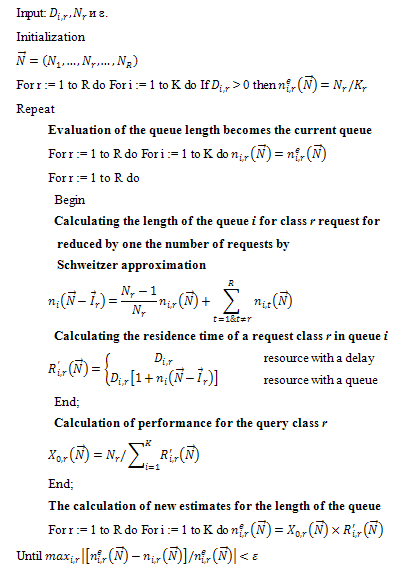Abstract
Introduction
The current stage of social development characterized by increasing the role of information in all spheres of human activity. The influence of this component determines the formation of a qualitatively new infrastructure in which information systems are leading.
Today, with the help of information systems to solve various problems, the use of information technology opens up new possibilities in the field of data transmission and processing.
Aims and Objectives
Design modifications of the TEI by using a Markov model, which will provide more accurate quantitative results of the use of the information system.
- Research objectives:
- The classification of methods for analyzing the effectiveness of implementation and operation of information systems;
- Design modifications of the TEI;
- Analysis of the effectiveness of new or modifications to existing components of information systems.
Urgency of the theme
Any economic processes at the global level or within individual organizations include the generation and use of information as a means of control and regulation of activity. Ever-increasing volumes and increasing demands for quality information cause the creation and implementation of information systems to work effectively.
Today is the basic characteristic informatization development and operation of the current socio-economic systems, so the level of implementation of information systems to a large extent determines the development of the country.
Scientific novelty and practical value
Master's thesis contains a modification of the "standard" method by using a Markov model. The developed method can be used to analyze the effectiveness of existing information systems or to analyze the implementation of new projects.
Review of research on the topic
Question the effectiveness of information systems involved in a number of scientists and IT managers.
Among local researchers involved in this problem Titorenko G, Trofimov V, Karminsky A, Baronov V, Baldin K and many others.
Abroad the matter handled by experts Gartner Group, Hubbard Decision Research, Microsoft, Forrester Research and others
In DonNTU questions the effectiveness of computer science masters Resnick E. and Abroskina N., lecturer Ph.D. Mikhailova T.
Summary of individual results available at the time of completion of the abstract
- Typically, when evaluating the effectiveness of information systems used by the following methodological approaches [1]:
- The portfolio approach
The basic idea - the transfer of business processes with an indication of all possible means of automation and optimization in comparison. Portfolio approach is used to evaluate the effectiveness of the IT company's management on the basis of the assessment carried out by specialists of IT departments. Evaluating the effectiveness of the IT portfolio, as a rule, in terms of productivity (of course, the optimization of business processes within the team implementing projects to integrate its IT solutions for the enterprise). Portfolio approach is designed to head the company, which in simple and accessible form gets all the minimal and sufficient information to select the strategic direction for IT development in the enterprise. - The budget approach
The budget approach is based on assumptions about the guaranteed efficiency of IT in the budgeting procedures of well-formed IT, motivation and control over spending. This approach is used by companies with already formed an IT economy, when most of the IT budget goes not to the introduction of new IT solutions, while maintaining the already implemented IT (more than 70% of budget). Typically, companies determine the percentage of, for example, the company's revenue is spent on IT investments. At the same time a key parameter in the rationale for the formation of such a budget is an increase in labor productivity. - The project approach
Modern financial theory suggests four basic ways to calculate the efficiency of the project and its value to the company: the payback period, return on investment, internal rate of return and net income from the project, taking into account the cost of capital, reduced to the present day. A detailed description of the methodology is in any serious financial management. - Labor productivity and capital
Implemented by the effect of IT is a complex interplay of economy, capital, labor productivity growth and the creation of new value added. Modern economics measures the effect of IT on three levels:
1. macro;
2. company level;
3. executive level.
Existing methods of evaluating the effectiveness of generally divided into four groups: the methods of investment and financial analysis, qualitative and probabilistic [2].
Investment analysis - is a common tool for the justification for any business project. To evaluate the profitability of the IT project is most often used so-called dynamic methods, based mainly on discounted generated by the project cash flows. Thus, the methods of investment analysis allows to evaluate the economic parameters of the implementation and use of IP by analogy with the assessment of any investment project.
In the methods of financial analysis used by traditional approaches to financial calculating cost-effectiveness in relation to the specifics of IT and the need to assess risk. The advantage of financial practices - in their fundamental principles, borrowed from the classical theory of economic efficiency of investment. These methods use the standard in the financial field criteria (net present value, internal rate of return, etc.) and operate on concepts of inflow and outflow of funds, which require specificity, and accuracy.
Qualitative evaluation methods, also called heuristics, complement the quantitative calculations that can help assess all implicit and explicit factors of effectiveness of the IP and link them with the overall strategy of the company. This group of methods allows professionals to choose the most important characteristics for these systems, depending on the specific products and activities of the enterprise, to establish relations between them, eg by factors of importance.
In the probabilistic methods are used, statistical and mathematical models to assess the likelihood of risk. These methods are needed to assess the future impact of the use of information systems, but is still not widespread in practice, both quantitative and qualitative.

Figure 1 — Estimation methods of efficiency of information systems
The total economic effect (Total Economic Impact, TEI) - heterogeneous methodology developed by Forrester Research. It allows you to evaluate the project for the implementation of a component information system in terms of three indicators - "Costs", "Benefits" and "Flexibility."

Figure 2 — Application of the TEI (Animation, GIF Animator, 7 shots,
6 reps, volume - 107 KB size - 395x155)
"Costs" is calculated by the method of "Total Cost of Ownership» (TCO) and is the only quantitative assessment of this technique. "Benefits" and "Flexibility" is a qualitative assessment.
"Benefits" can be judged according to the opportunity to introduce a product or component information system requirements of the project implementation. Additional features that will appear in the work of employees following the introduction of such a component or product should be evaluated both in terms of efficiency of work, and their effects on the identified operational and technological risks.
"Flexibility" is regarded as a measure of the complexity of the implementation process. That is, estimated costs to be incurred by "turning on" a new component in the enterprise information system - will require a reworking of the entire system due to the introduction of a new enterprise component, there are sufficient opportunities to configure the component to connect it to the existing system will require the adaptation of such a component and so on.
The final step methodology TEI - analysis of risks arising on the acquisition, implementation and operation of analyte information system. Analysis of this indicator must take into account the availability and stability parameters of manufacturers, products, architecture, corporate culture, the amount and timing of the project.
To develop a modified method of TEI in the algorithm of the approximate analysis of the mean values for queuing systems with the queries of multiple classes (Schweitzer model).

Figure 3 — Algorithm for the approximate analysis of the mean values
QS with requests for multiple classes [4]
In general, the information system is a complex structure with the stochastic nature of the operation, and is based on queuing systems, processes that are random, in many cases, Markov, which is used to describe the Markov model [6, 7].
The idea of modifying the method of TEI is to make use of the model Schweitzer, a more accurate quantitative results of the use of the information system and a comparative analysis of IT projects in order to select the most optimal technical and cost parameters.
- References
- Ледовский А. Методологические подходы к оценке эффективности ИТ-проектов [Электронный ресурс]. — Режим доступа: http://citcity.ru/13854/
- Ядыков С. Эффективность информационных систем — докопаться до истины. // «Консультант» — 2010, №5
- Смирнов А. Методы контроля расходов на IT и получение гарантированного уровня сервиса [Электронный ресурс]. — Режим доступа: http://www.cfin.ru/itm/it_eval_meths.shtml
- Информационные технологии: учебник / под ред. В.В. Трофимова. — М.: Издательство Юрайт; ИД Юрайт, 2011. — 624 с. — (Основы наук).
- Производительность Web-служб. Анализ, оценка и планирование: Пер. с англ./Дэниел А. Менаске, Виргилио А.Ф. Алмейда. — СПб: ООО «ДиаСофтЮП», 2003. — 480 с.
- Википедия, свободная энциклопедия [электронный ресурс] — Режим доступа: ru.wikipedia.org/Теория массового обслуживания
- Бережная Е.В., Бережной В.И. Математические методы моделирования экономических систем: Учеб. пособие. — 2-е изд., перераб. и доп. — М.: Финансы и статистика, 2006. - 432 с: ил.
In writing this essay master's work is not completed yet. Final completion: December 2012. The full text of the work and materials on the topic can be obtained from the author or his head after this date.
